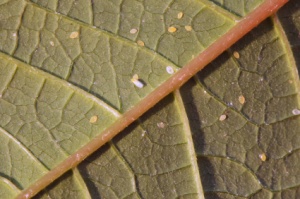Get Rid of Whiteflies on House Plants
Find out how to get rid of whiteflies on indoor plants. Here you'll discover how to identify whitefly, where to find them, the damage they do, and the best ways to kill whitefly on houseplants.
Fortunately, they're not as common in the home as in a greenhouse, where they have a lot more plants to feed on. However, they do a lot of damage, if not controlled.
What Whiteflies Look Like
Whiteflies (Trialeurodes vaporariorum) look like tiny moths with 4 powdery white wings. At the adult stage, they're about 1/16 inch (.16 cm) long.
Their eggs and larvae are yellowish-green in color and barely visible without a magnifying glass.
Life Cycle of a Whitefly
Whiteflies life cycle includes a few stages, including eggs, larvae, pupae, and adult.
Only the adult whitefly is susceptible to insecticides, so spraying must be repeated to catch each generation as it matures to the adult stage.

Where to Find Whiteflies
These tiny winged insects will likely be found on the undersides of leaves where they suck plant juices, causing the leaves to turn yellow and appear limp. They excrete sap called honeydew -- a sticky substance which encourages growth of sooty mold. Honeydew is sweet and sometimes attracts ants that like to feed on it.
You'll see them flutter around like snowflakes when an infested plant is disturbed.
They're not picky eaters -- they'll feed on more than 60 species of plants. Soft-leaf plants are among of their favorites, including African violet, chrysanthemum, flowering maple, gerbera daisy and Cape primrose.
It's a good idea to check over your plants once a week for any signs of an invasion -- wilted or weakened growth, yellow mottled leaves, leaf drop, sticky honeydew, and sooty mold.
Disclosure: Guide-to-Houseplants.com participates in affiliate programs offered by the advertisers featured here. If you make a purchase after following the links on this page, I may receive a commission at no additional cost to you.
How to Get Rid of Whiteflies on Houseplants
Isolate and treat your plant as soon as you notice the infestation. Whitefly reproduces quickly, causes a lot of damage, then can eventually kill your plant. Whitefly control will prevent them from invading your other houseplants.
Prune heavily infested leaves as soon as you notice them. They're not likely to recover from the feeding by these plant-sucking insects.
If only a few leaves are infested, wipe off eggs and larvae with a damp cloth.
The adults are susceptible to insecticides. Use Bonide® Insecticidal Soap Ready to Use Spray made for indoor plants. Spray every 2-3 days for 4 weeks or as needed. Make sure your plant is listed on the product label. Read the label carefully and follow the manufacturer's directions for use.
How to Use Sticky Traps for Whiteflies
Put a yellow sticky whitefly trap on a stake in each pot of an infested plant to catch them.
Whiteflies are attracted to the bright yellow color and once they land on the sticky surface...they're stuck.
These sticky traps are effective in attracting and catching flying pests -- whiteflies, thrips and fungus gnats. They're safe to use indoors.


